Toxicology
New Study Adds To PM Harms: Exposure Linked to Increases in Juvenile Delinquency
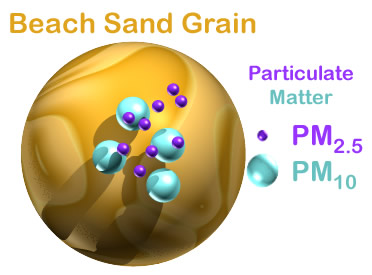
The first study to look at the effects of PM pollution exposure on the social behavior of children found that that the more bad air a child inhaled, the more likely they were to engage in delinquent activity.
Published in December’s Journal of Abnormal Child Psychology by researchers at UCLA, UC Irvine, and Orebro University in Sweden, “Longitudinal Analysis of Particulate Air Pollutants and Adolescent Delinquent Behavior in Southern California” is already a landmark study in the growing field of PM research. It further demonstrates the similarities between PM and the handful of other neurotoxins linked to delinquency – like lead.
While past studies have identified a range of neurological impacts associated with PM pollution, including Autism and Parkinson’s Disease, this is the first time it’s been linked specifically to anti-social behavior. According to the authors, cumulative exposures were found to result in developmental differences lagging as many as 3 to 4 years behind the norm.
Not surprisingly, African-American boys, and children who lived in neighborhoods with poorer air quality and less green space had both higher PM exposure levels and higher delinquency rates.
This is only the latest reason why Downwinders at Risk has identified PM as Air Pollution Enemy #1. There’s not another pollutant that’s been linked to so many different health harms – from lung cancer to strokes and heart attacks, to immune and reproductive system damage to a host of brain illnesses both profound and subtle.
All of these harms are caused by “normal” levels of exposure to PM. And that’s why that exposure level must come down.
STUDY: Even Very Low Levels of Air Pollution Increase Mental Illness in Children
 Most of us are used to hearing about the traditional physical ailments caused by breathing poisoned air, and even about the more recently-connected neurological impacts. But a new Swedish study is the first time we’ve seen a report linking air pollution to mental illness in children.
Most of us are used to hearing about the traditional physical ailments caused by breathing poisoned air, and even about the more recently-connected neurological impacts. But a new Swedish study is the first time we’ve seen a report linking air pollution to mental illness in children.
The new research, peer reviewed and published by the journal BMJ Open, found that relatively small increases in air pollution were associated with a significant increase in treated psychiatric problems. Its conclusions are consistent with a growing body of evidence that air pollution can affect mental and cognitive health.
Two things about this study stand out: 1) How rigorous it was. It examined the exposure levels of over 500,000 Swedish kids under 18 for more than three years; 2) The very low levels of air pollution linked to increased diagnosis and treatment. This is a familiar story, but it’s driven home by a new correlation to mental illness. The more we examine the impacts of toxins on people, the more we understand there is no “safe level” of exposure we can count on. The variety of nuanced adverse health effects will not be as obvious as cancer or asthma. Instead they might show up as depression, or the inability to conceive.
The pollutants studied were Particulate Matter and Nitrogen Dioxide. There’s already a large body of evidence linking PM pollution to neurological diseases and learning disabilities. Tiny PM uses the body’s bloodstream as a highway to hitchhike its way to any organ. Since so much of our blood goes to our brain, it’s not surprising that so many brain functions are affected by it.
“The results can mean that a lower concentration of air pollution, first and foremost from traffic, may reduce psychiatric disorders in children and adolescents,” said Anna Oudin, at Umeå University, who led the study. “I would be worried myself if I lived in an area with high air pollution.”
But has her own study shows, you don’t have to live in areas with “high air pollution” to be impacted.
Pics from Our “Meet the Drones” Mixer
 Here's the link to some pictures of our October 6th "Meet the Drones" Mixer featuring the squadron from University of Texas at Dallas.
Here's the link to some pictures of our October 6th "Meet the Drones" Mixer featuring the squadron from University of Texas at Dallas.
Thanks to TCU's Dr. Mike Slattery for hosting the public debut of our North Texas CLEAN Air Force – an exciting new effort combining citizen know-how with academic expertise to better help us identify DFW air pollution problems. Representatives from TCU, UTA, UTD, UNT, UNTHSC were on site. Thanks as well to all the supporters and curiosity-seekers who showed up to see the show.
This was the first of what we hope will be a series of such events around North Texas to show off the capacity and potential of this new tool for citizens. Stay tuned for news on when we'll be coming to a campus near you.
New Study: Premature Births Caused by Dirty Air Cost the US $4 billion a Year
 There are no shortages of studies linking bad air with birth defects and premature births. But until now no one has taken on the task of trying to add up the national toll in both lives and money.
There are no shortages of studies linking bad air with birth defects and premature births. But until now no one has taken on the task of trying to add up the national toll in both lives and money.
In a study published in Environmental Health Perspectives on Tuesday, UCLA researchers estimated that almost 16,000 premature births across the country in 2010 — about 3 percent of the nationwide total of 475,368 — were related to exposure to high levels of "air polution" – in this case the insideous and ubiquitos Particulate Matter, or PM. These premie births cost the system $4.33 billion, including $760 million spent on prolonged hospital stays and long-term use of medications, as well as $3.57 billion in lost economic productivity due to physical and mental disabilities associated with preterm birth.
"For policy makers, decisions about regulating air pollution come down to a trade off between the cost of preventing air pollution and the health and economic benefits of limiting air pollution sources," study author Dr. Leonardo Trasande, associate professor in the Departments of Pediatrics, Population Health and Environmental Medicine at NYU Langone Medical Center. "Without data documenting the health effects of air pollution on preterm births, there's only one side to that discussion. So what we did was to quantify the disease burden and economic cost associated with preterm birth that could be traced to air pollution."
Developing fetuses are very vulnerable to pollutants of all kinds. That's why doctors tell women not to smoke during pregnancy. Exposures to high levels of air pollution increases toxic chemicals in the blood and can weaken the immune system, causing stress to the placenta and leading to preterm birth (defined as birth before 37 weeks of pregnancy)
PM pollution represents a threat because the particles are so tiny and fine they pass from your lung right into your blood stream and go where ever the flow takes them – to your heart, your liver, your brain. PM can also act as a kind of toxic suitcase for whatever other polutants came out of the same smokestack or exhaust pipe – metals, endocrine disruptors, etc.
Premature babies face greater risk of health issues including heart and breathing problems, weaker immune systems, anemia, jaundice and other complications. Longterm, while many preemies grow up healthy, they can be more likely face hearing or vision problems or developmental disabilities.
The study authors emphasized that this burden is preventable and say they plan to share their findings with policymakers in an effort to help shape regulations and laws designed to reduce air pollution.
"This really speaks to the need to continue with efforts to reduce air pollution from coal-fired power plants and vehicle exhaust," Trasande said. We have some of those in Texas.
Monthly TEDX Teleconference Tutorial on the Hazards of Fracking
 Founded by the late great Theo Colburn, who along with her co-authors of "Our Stolen Future" way back in 1996 just about invented the field of "endocrine-disrupting chemicals," the Endocrine Disruption Exchange (TEDX) is holding a monthly teleconference series begining in April focusing on chemicals associated with fracking.
Founded by the late great Theo Colburn, who along with her co-authors of "Our Stolen Future" way back in 1996 just about invented the field of "endocrine-disrupting chemicals," the Endocrine Disruption Exchange (TEDX) is holding a monthly teleconference series begining in April focusing on chemicals associated with fracking.
First up on Thursday, April 7th at 1 pm is Dr. Chris Kassotis, who's been looking at the connection between fracking chemicals and surface and ground water contamination near fracking sites. According to the TEDX release, Kassotis will speak about…
"…his recently published research demonstrating increased endocrine disrupting activity in surface and ground water near fracking wastewater spill sites, as well as nuclear receptor antagonism for 23 commonly used fracking chemicals. His studies have shown prenatal exposure to a mixture of those chemicals at likely environmentally relevant concentrations resulted in adverse health effects in both male and female C57 mice, including decreased sperm counts, modulated hormone levels, increased body weights, and more. Dr. Kassotis will also discuss his recent work showing increased receptor antagonism downstream from a wastewater injection disposal site.
Dr. Kassotis is a Postdoctoral Research Associate in the Nicholas School of the Environment at Duke University. He completed his PhD at the University of Missouri working with Susan Nagel to assess unconventional oil and gas operations as a novel source of endocrine disrupting chemicals in water, and the potential for adverse human and animal health outcomes from exposure.
This April get together is one of three briefings being given from now until June. According to a preview of the next two calls:
Thursday May 5, 2016, 1:00 pm Central – Dr. Shaina Stacy will discuss "Perinatal outcomes and unconventional natural gas development in Southwest Pennsylvania"
Thursday June 2, 2016, 1:00 pm Central – Dr. Nicole Deziel will discuss "A systematic evaluation of chemicals in hydraulic-fracturing fluids and wastewater for reproductive and developmental toxicity"
You have to go online and register as a participant if you want to listen in or ask quesitons via a live chat line.
Study: Combusted PM Pollution Up to Five Times as Lethal As Non-Combusted Kind. Burning is Bad.
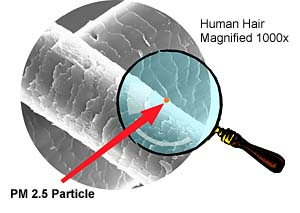 Long term exposure to small particulate pollution from combustion sources, specifically coal-fired power plants, is up to five time more likely to kill you through heart damage than other forms of natural or human-made "PM."
Long term exposure to small particulate pollution from combustion sources, specifically coal-fired power plants, is up to five time more likely to kill you through heart damage than other forms of natural or human-made "PM."
That's the conclusion of new comprehensive study comparing risks from breathing-in the tiniest specs of soot from combustion sources for over 450,000 Americans in 100 cities from 1984 to 2014. Published in the journal Environmental Health Perspectives this month to coincide with the Paris climate talks, the study has ten co-authors and promises to be a milestone in the long fight to reduce this form of pollution.
Combustion of any sort releases fine and ultra-fine particles of soot, or "Particulate Matter" in the often antiseptic regulatory-speak of environmental regulation. These specks differ from dust particles or fireplace soot in that they're much, much smaller and so can be inhaled deeper into the lungs, and then, even pass from the lungs into the blood steam to affect other organs and systems. It's their tiny size that makes PM pollution dangerous on its own. Over the last 30 years, scientists and public health officials have gone from being worried about PM 10 (10 microns or less), to PM 2.5 (2.5 microns or less – about 100th of the width of a human hair), to Ultra-fine Particles.
But soot from combustion also carries residues of whatever was being burned in the facility it came from, and this makes it doubly toxic. If you're burning coal, the soot might carry bits of Mercury, Arsenic, Cadmium and Lead, for example. The new study says that difference is what really drives up risk for people breathing-in coal plant PM.
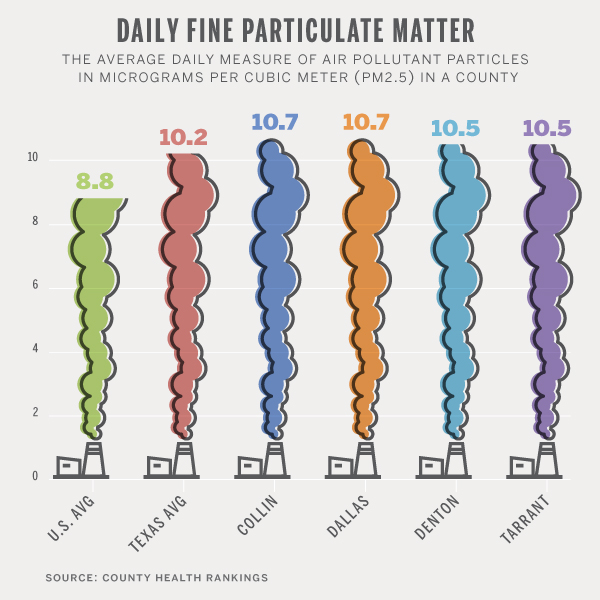
Locally, DFW is chock full of large industrial sources of combustible PM.
We're surrounded by five coal plants in an arc on its northeastern to southeastern side. That means we're downwind of their pollution, including their particulate matter pollution, most of the year. Their impact on local smog levels has recently been chronicled by Downwinders' study from UNT.
PM Pollution would follow approximately the same patterns although heavier particles fall closer to the source, while the really fine particles drift for hundreds or thousands of miles. Luminant’s 2013 Emissions Inventory submission reports 1400 tons of 2.5 particulate matter in a single year at its Big Brown plant. And that may be a severe underestimate. Big Brown’s two Units have exceeded the Texas SIP’s opacity limit of 30 percent on thousands of occasions over the past decade.
Luminant's Martin Creek plant released 2,018 pounds of mercury into the environment in 2013, according to the Toxic Release Inventory, and in fact Texas hosted the top three mercury polluters among all coal plants in the US that year.
Closer in, there's the three Midlothian cement plants with a total of four kilns now. Modernization and controls forced by 20 years of campaigning by Downwinders have brought the numbers down dramatically, but they're still huge facilities that deal in both a dusty raw material, and burning lots of coal and industrial wastes like tires and used oil, and even car parts, to turn that into a higher grade of raw material. When you burn exotic materials with coal, you turbocharge the toxicity of the PM pollution even more. In 2013, the last year the state has numbers posted online, the three cement plants released approximately 440 tons of 2.5 PM pollution.
But cement plants weren't included in the study and so the risk evaluations in it for DFW are underestimated.
Midlothian is also the home to the very large French-owned Amersteel (formally Chaparral Steel) secondary steel mill and steel mills were included as a source category in the study and were also associated with a higher mortality rate. Just about every 18-wheeler trailer you see on local highways loaded with crushed cars is headed to this facility – across the street from the TXI cement plant. Imagine the residues on the soot from melting down thousands of used cars into liquid metal. In 2013, the plant released 133 tons of PM 2.5.
But by far, the largest PM polluter in the DFW area, bar none is the Owens-Corning fibreglass plant in north Waxahahchie, along I-45. It released a whopping 300 tons of PM 2.5 pollution in 2013 alone. No other facility comes close – not the cement plants or the steel mill down 287. Not the GM plant in Arlington. It's not known how much of Owens-Corning PM is combusted however. It could be from the manufactiuring process.
Diesel engines in vehicles were also included, and the study found they has an association with higher mortality, but not nearly as significant as coal plants or steel mills. There's been a steady stream of studies tying highway pollution to respiratory and neurological illness among near-by populations, especially children. Most of the risk is assigned to PM pollution, and most of that is coming from diesels.
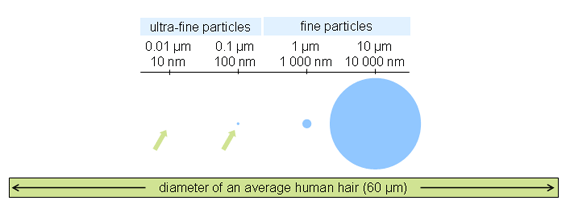
Just as important as the conclusion that coal-combusted particulate matter is significantly more dangerous than your average speck of dust is the study's indictment of current EPA risk assessments that operate on exactly the opposite assumption. The authors are critical that the Agency still weighs the risk of desert dust the same as combusted soot in computing long-term human health effects.
There are potentially enormous public heath and policy implications for North Texans in the study's conclusions.
First, the campaign to get the most modern anti-smog controls included in the latest DFW air plan has the side benefit of reducing PM pollution too. Selective Catalytic Reduction (SCR) on the cement kilns and coal plants decreases smog-forming pollution by up to 90%, and makes an effective additional PM catcher as well, increasing soot capture by 30-50%. The technology is particularly effective on the kind of PM that carries dangerous heavy metals like Mercury. Of course, retiring already-obsolete coal plants would eliminate the threat all together.
Likewise, electrification of compressors would not only lead to decreases in smog-forming emissions, but PM pollution from those sources as well.
Next, it means the already large public health costs of bad air in DFW just published by Dr. Robert Haley of UTSW in his own study are severely underestimated, since they were based on the EPA's own risk assessment software that doesn't weigh the harm of coal power plant PM differently from any other speck of PM 2.5. Adjust those numbers for the exposure to toxic soot and you could see a huge increase in lives lost, illness caused, and dollars spent.
Finally there are implications for almost very other source of combustion around – burning is bad. Where's there's a flame, a boiler, a furnace, a process that means burning something to get something in return, there's going to be PM pollution. What you burn is as important as how you burn it. Burn coal and get the residues of coal on the PM. Burn hazardous waste, and you get the residues from those wastes on the PM. Burn diesel fuel in your truck or car and get residues from that fuel mix packed away in your particulate matter.
As one of the major authors of the study said, if you want to do something about this kind of pollution – start with the most toxic forms of combusted PM. Those mostly come from large industrial sources – the coal plants, cement kilns, and compressors already in our sights because they're also smog polluters. We knew they were a problem. Now we know even more about why they're a bigger problem.
Recent Studies Highlight the Gap Between 21st Century Science vs 20th Century Regs
 Imagine writing rules for flying commercial passenger jets that don't consider the impacts of wind, weather, and other flight paths on how they operate.
Imagine writing rules for flying commercial passenger jets that don't consider the impacts of wind, weather, and other flight paths on how they operate.
Now imagine writing rules for how much poison you can breathe, drink, eat, or touch that don't consider the impacts of those poisons in combination with one another inside you, or vastly underestimate the amount of poisons you're being exposed to in the first place.
Both approaches to regulations would be reckless. But whereas one is ridiculous, the other is law.
Two recent studies once again demonstrated how wide and misleading the gap is between current environmental health science and current environmental health regulations.
One survey that included the work of almost 200 published authors coordinated by California Pacific Medical Center Research Institute concluded that combinations of different chemical exposures, even if all of them were within so-called "safe" levels, could increase cancer risks.
“Many [chemicals] have the possibility, when they are combined, to cause the initiation of cancer,” said Hemad Yasaei, a cancer biologist at Brunel University in England, one of the authors of the report. “They could have a synergistic or enhanced effect.”
But this is not the way that chemical exposures are regulated in the U.S.
Instead, the EPA tests one chemical at a time on lab animals, exposing them to progressively smaller amounts until the chemical no longer causes tumors. The Agency takes that dose, determines the equivalent for humans, and applies what is called a “margin of safety” by declaring that some small fraction of that low dose is safe for people.
This approach reflects the Medieval axiom, “The dose makes the poison." However, it doesn't reflect modern human physiology.
That "margin of safety" is never put to the test as part of an epidemiological study to correlate exposure with safety. It's just assumed. And it's also assumed that the margin will remain the same no matter how man other harmful exposures the body may encounter. This latest meta survey of the data shows that approach to be a wrong-headed assumption.
For example, endocrine disrupting chemicals can actually be more toxic at lower levels depending when a fetus is exposed to them because the human body is attuned to respond to minute amounts of natural hormones such as estrogen and testosterone during development.
Different chemical exposures can affect the body like bird shot. One pellet alone is unlikely to cause you a problem, but dozens or hundreds of pellets will start to add up, effecting different systems, and cause a catastrophic failure.
"Since each of these chemicals affects different processes that could lead to cancer — bisphenol A makes cells less sensitive to signals to stop reproducing, for example, while atrazine encourages inflammation — it’s plausible that consuming mixtures of these chemicals is riskier than consuming any one individually."
We're living with over 80,000 different synthetic chemicals on the marketplace. This survey only focused on 85. Of those 85, 50 were found to affect cancer-causing processes in the body, even at very low doses.
"We live in a chemical soup,' said toxicologist Linda Birnbaum, director of the National Institute of Environmental Health Sciences, who was not involved in the new study. Considering the safety of individual chemicals is a lot like looking at the trees, but missing the forest, Birnbaum said. When doing research to determine chemical safety, 'we’ve got to start thinking more about what reality is,' she said. This could mean sweeping changes in rules about the levels of chemicals considered safe in drinking water, food, and air. 'I’d like to see regulators and policy makers start looking at the totality of the exposure instead of one chemical at a time,” she said.
Yes, but when will our modeling and testing for human chemical exposure be as sophisticated as our human body's reaction to it in real life?
And what if official estimates about multiple chemical exposures were not only discounted, but the estimates for how much chemical you're being exposed to everyday was vastly underestimated?
Most people don't understand that numbers about the size of toxic releases from industry are generated mostly from estimates based on calculations, not actual measurements at the facility or in the environment. You have a chemical plant or cement kiln, it has x, y and z kind of equipment on it. That equipment is rated by the manufacturer to be X efficient, and therefore government regulators assume it is. There is no real time measuring of pollution for most facilities and most kinds of chemicals. The "emissions calculations" that go into a permit or "tons per year" number are guesses, and may or my not actually come close to describing what's coming out of the facility.
The weakness of that part of the regulatory system was revealed by a Environmental Defense Fund study showing that EPA estimates about the amount of methane coming off gas sites were off by as much as 50%.
Methane is a bad actor in and of itself because it's a greenhouse gas that has 25 times greater impact on global warming than carbon dioxide. But if methane is being underestimated at gas sites, so probably are other, more directly toxic kinds of pollutants, like Benzene.
Almost every time a researcher bores down to look at a specific plant or industry, actually testing the accuracy of the calculations with real world data, they find more air pollution than estimated. It's just a matter of faith or luck that we may or may not be exceeding "safe" levels of exposures, which may or may not be that safe to begin with.
To recap: We're exposed to lots and lots of chemicals. We don't really know how much, or how much is safe for you to be exposed to, and we still have an environmental health testing protocol that's the toxicological equivalent of using leeches. But don't worry, the EPA is "overregulating" industry!
Study: PM Pollution is an “Environmental Neurotoxin” to Brain
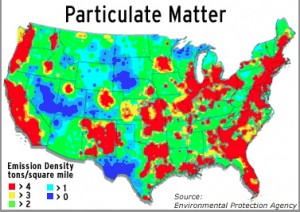 It was just two months ago we featured the results of a study out of Boston that linked exposure to Particulate Matter, or PM pollution to brain aging and increased risk of dementia. Before that, we highlighted studies linking PM to autism and Parkinson-like symptoms. Now comes one more long-term, peer-reviewed report that connects ambient levels of the pollution to accelerated brain aging.
It was just two months ago we featured the results of a study out of Boston that linked exposure to Particulate Matter, or PM pollution to brain aging and increased risk of dementia. Before that, we highlighted studies linking PM to autism and Parkinson-like symptoms. Now comes one more long-term, peer-reviewed report that connects ambient levels of the pollution to accelerated brain aging.
This one is from the University of Southern California and looked at over 1,400 women without dementia who were initially enrolled in a large health study from 1996 to 1998. Researchers measured their brain volume with M.R.I. scans in 2005 and 2006, when the women were 71 to 89 years old.
Using residential histories and air pollution monitoring data, they estimated their exposure to PM air pollution from 1999 to 2006. For each increase of 3.49 micrograms per cubic centimeter (μg/m3) cumulative exposure to PM, there was an associated 6.23 cubic centimeter reduction in the subject's brain white matter, the equivalent of one to two years of brain aging. The current EPA standard for 24 PM exposure is 35 μg/m3, while the annual average standard is 12 μg/m3, although many leading scientists now believe there's no "safe" level of exposure to PM pollution. That is, any amount of exposure is capable of doing some damage.
The association between pollution exposure and brain aging in the USC study remained after adjusting for many variables, including age, smoking, physical activity, blood pressure, body mass index, education and income.
“This tells us that the damage air pollution can impart goes beyond the circulatory system,” said the lead author, Dr. Jiu-Chiuan Chen, an associate professor of preventive medicine at the Keck School of Medicine at the University of Southern California. “Particles in the ambient air are an environmental neurotoxin to the aging brain.”
It's important to note that all of these women were subject to ambient levels of PM pollution, that is, levels that we're all being exposed to on a daily basis living in the modern world. Everyday kinds of exposure to this substance is making our brains age prematurely.
What makes PM pollution dangerous to human health is the fact that its soot particles are so tiny that they can actually cross from the lungs into the blood stream and travel anywhere in the body, including the brain. Soot is a toxic substance on its own, but when its carrying the residues of whatever was burned to produce it – benzene in a combustion engine, mercury from the coal in a power plant, dioxins from "hard to recycle plastic waste" in a cement kiln – it becomes even more dangerous.
While PM pollution remains an important factor in respiratory diseases, heart attacks and strokes, the more insidious effects to the brain it causes are raising its profile among policymakers and activists. They have implications for zoning highways near schools, parks, and residences, as well as pollution control measures at industrial facilities.
PM is one of the best examples of "the closer we look, the more trouble we find" phenomena in environmental health science. Advances in technology and medicine show that subtle changes in exposure to chemicals that went unnoticed before can have profound consequences to our species.
Study: Endocrine Disrupting Chemicals Tied To Male Birth Defect
 When the phenomenon of toxic exposures first hit the popular culture, it was all about cancer risks. This or that chemical or product increased your cancer risks. Cancer risks still define the way the EPA regulates chemicals with a theoretical safe threshold of one cancer case in a million. Cancer is the headliner of environmental health impacts. It's the bluntest short cut to labeling a substance as toxic.
When the phenomenon of toxic exposures first hit the popular culture, it was all about cancer risks. This or that chemical or product increased your cancer risks. Cancer risks still define the way the EPA regulates chemicals with a theoretical safe threshold of one cancer case in a million. Cancer is the headliner of environmental health impacts. It's the bluntest short cut to labeling a substance as toxic.
But the last twenty years of research have been all about examining the less well-known, but perhaps more insidious non-cancer impacts on the human body of toxic chemical exposures. Damage to immune systems that then lead to more serious illness, links to debilitating diseases like Parkinson's and Alzheimer's, more abrupt consequences like strokes and heart attacks. And birth defects.
Birth defects are one of the most underrated impacts of toxic exposure, but they're capable of slowly but surely changing the characteristics of humanity itself.
There is now a whole new school of study, "Epigenetics," that didn't even exist a decade ago. It examines how damage of a person's DNA, or the factors influencing how that DNA works, are passed down to subsequent generations. Such damage can skip a generation, or two, so that your grandfather's or great grandfather's exposure to really bad stuff at his workplace affects your DNA and physiology today.
By allowing so many untested chemicals into the marketplace and making citizens swim through them as they go about their lives, industry and government are conducting a planet-size laboratory experiment that we are always trying to understand after the fact.
Another example of new knowledge is the discovery and labeling of certain chemicals as "Endocrine-Disruptors." Before the mid-1990's, we didn't even have such a phrase.
Our endocrine system is the network of glands and hormones that regulates many of the body's functions, including growth, development and maturation, as well as the way various organs operate. The endocrine glands — including the pituitary, thyroid, adrenal, thymus, pancreas, ovaries, and testes –– release carefully-measured amounts of hormones into the bloodstream that act as natural chemical messengers, traveling to different parts of the body in order to control and adjust many life functions.
Endocrine disruptors are chemicals that interfere with that signaling and regulation of body functions, and produce adverse developmental, reproductive, neurological, and immune effects in both humans and wildlife. They include Dioxins, Phthalates, DDT, PCBs, and Bisphenol A (BPA), and pose the greatest risk during prenatal and early postnatal development when organ and neural systems are forming.
Past studies of the effects of endocrine disrupting chemicals have often focused on the vulnerablity of reproductive systems to exposure to endocrein disruptors, producing the now familiar stories of male fish with female characteristics or via versa. In uterus, a fetus' chemical wiring can be crossed or short-circuited.
A new study from France involving over 600 boys looks to add to this trend, concluding that a expectant mother's exposure to Endocrine-disrupting chemicals raises the risk to a specific male birth defect, Hypospadias, by almost 70%.
Hypospadias is a condition where the opening of the urethra is on the underside of the penis rather than at the tip. The defect, which can be minor or quite severe depending on how far the opening is from the tip, can lead to problems with urination and, later in life, sexual difficulty.
The risk for those boys whose mothers were exposed to Endocrine disrupting chemicals was 68 percent higher than the unexposed boys. The researchers ruled out baby boys with known genetic risks for such defects. Working with hormone disrupting chemicals and living in homes near heavy polluters were both linked to more baby boys having the defect. Mothers were most likely to have boys with hypospadias if they worked as a cleaner, hairdresser or beautician. However, the researchers did say a limit of the study was attempting to estimate fetal exposure to such chemicals.
In a previous study, mothers in southeast England who were heavily exposed to endocrine disrupting phthalates on the job were about three times more likely to have a baby boy with hypospadias. Phthalates are used in some cosmetics, fragrances, food packaging and PVC plastics.
Hypospadias is one of the most common genital defects in baby boys, and most cases require surgery, often done before they reach two years old. In the United States, an estimated five out of 1,000 boys are born annually with hypospadias, while Europe’s rate is slightly less than two out of 1,000. “Nobody dies from hypospadias," said one of the researchers. "Most are cured with surgery, but if we can come up with some kind of prevention protocol, it could prevent a lot of surgeries and anxiety for families.”
New Study Finds Dangerous Levels of Toxic Air Pollution From Fracking
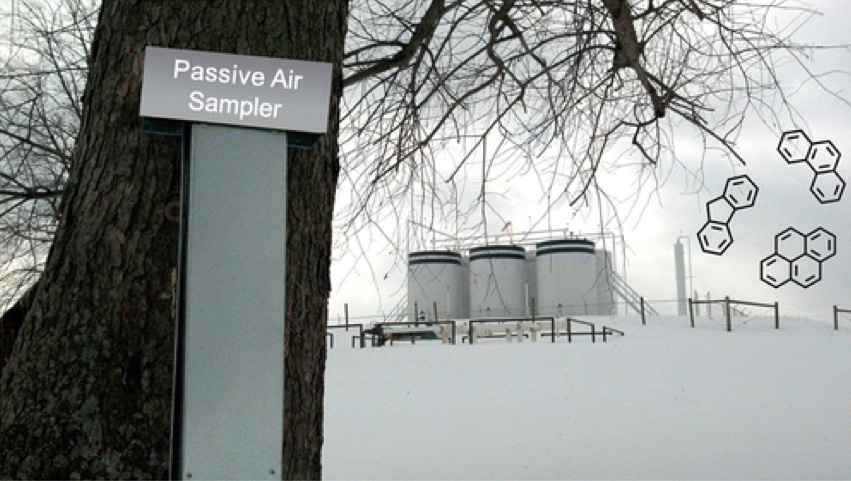 People living or working near active natural gas wells may be exposed to toxic air pollution at higher levels than the Environmental Protection Agency considers safe for lifetime exposure. That's the conclusion of a new study performed by scientists from Oregon State University and the University of Cincinnati, published in the March 26th edition of the journal Environmental Science and Technology.
People living or working near active natural gas wells may be exposed to toxic air pollution at higher levels than the Environmental Protection Agency considers safe for lifetime exposure. That's the conclusion of a new study performed by scientists from Oregon State University and the University of Cincinnati, published in the March 26th edition of the journal Environmental Science and Technology.
Sampling at various sites adjacent or downwind of fracking wells in Carroll County, Ohio over a three-week period last February revolved around 62 Polycyclic Aromatic Hydrocarbons (PAHs), a category of combustion-produced pollutants already linked too everything from childhood obesity to breast cancer, to lower IQ. Carroll County sits on top of the Utica formation, a gas rich shale deposit. The rural county is a hotspot of natural gas drilling and production, with more than one active well site per square mile.
“Air pollution from fracking operations may pose an under-recognized health hazard to people living near them,” said the study’s coauthor Kim Anderson, an environmental chemist with OSU’s College of Agricultural Sciences.
The study was initiated by citizens in the area who wanted to more about the health risks they were facing from fracking. They approached Anderson her peers and and the scientist designed the study to include citizen participation. They placed air samplers on the properties of 23 volunteers living or working at sites ranging from immediately next to a gas well to a little more than three miles away.
Anderson's samplers are aluminum T-shaped boxes containing specially treated polyethylene ribbons that absorb contaminants in a similar manner to biological cells. Volunteers were trained in proper handling of samplers and documenting of data.After the study period, the volunteers packaged the samplers in airtight bags, labeled them and mailed them back to Anderson’s lab at OSU.
Even the lowest levels – detected on sites more than a mile away from a well – were higher than previous researchers had found in downtown Chicago and near a Belgian oil refinery. They were about 10 times higher than in a rural Michigan area with no natural gas wells.
By looking at the ratios of individual PAHs detected by the samplers, Anderson and her team were able to discern whether they came directly from the earth – a “petrogenic” source – or from “pyrogenic” sources like the burning of fossil fuels. The proportion of petrogenic PAHs in the mix was highest nearer the wells and decreased with distance.
The team also accounted for the influences of wood smoke and vehicle exhaust, common sources of airborne pyrogenic PAHs. Wood smoke was consistent across the sampling area, supporting the conclusion that the gas wells were contributing to the higher PAH levels.
The researchers then used a standard calculation to determine the additional cancer risk posed by airborne contaminants over a range of scenarios. For the worst-case scenario (exposure 24 hours a day over 25 years), they found that a person anywhere in the study area would be exposed at a risk level exceeding the threshold of what the EPA deems acceptable.
The highest-risk areas were those nearest the wells, Anderson said. Areas more than a mile away posed about 30 percent less risk.
Estimated worst-case maximum residential exposure was 2.9 in 10 000, which is above the U.S. EPA’s acceptable risk level of one in a million. According to the study's abstract, "This work suggests that natural gas extraction may be contributing significantly to PAHs in air, at levels that are relevant to human health."
